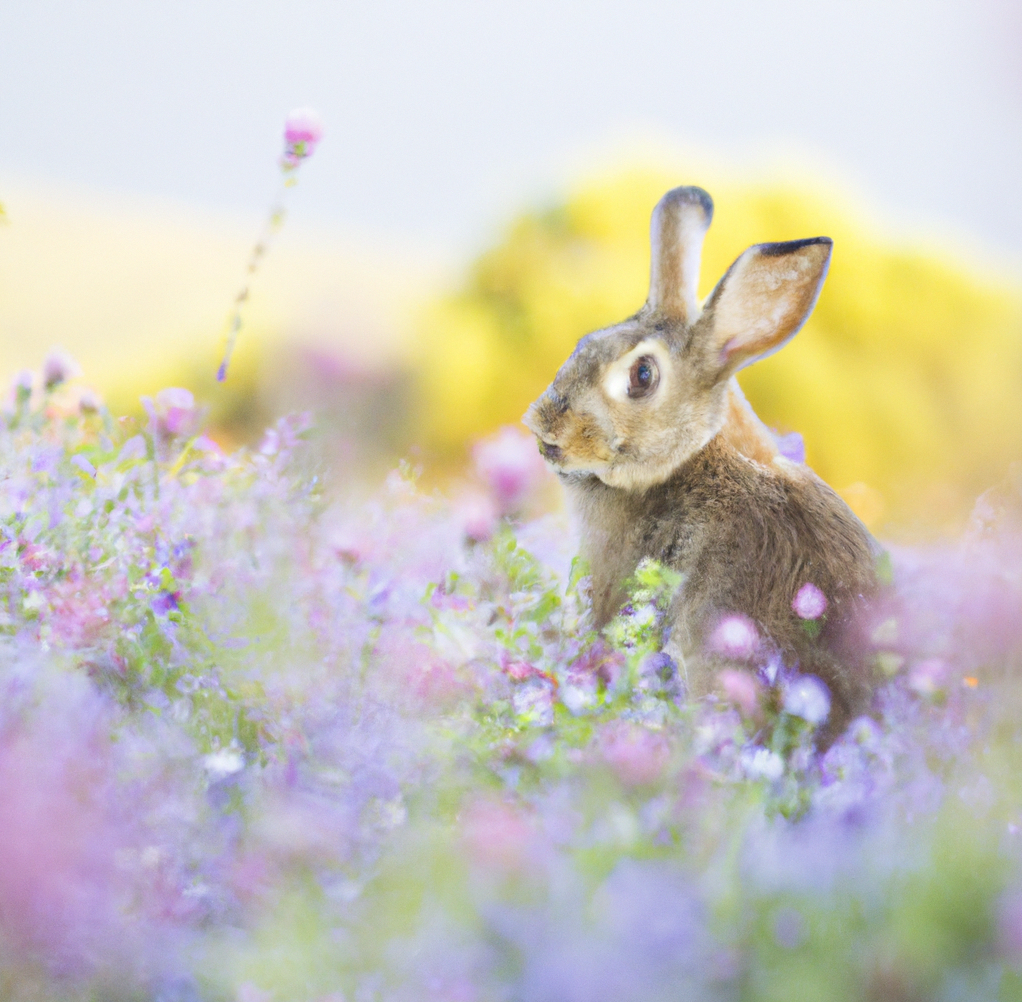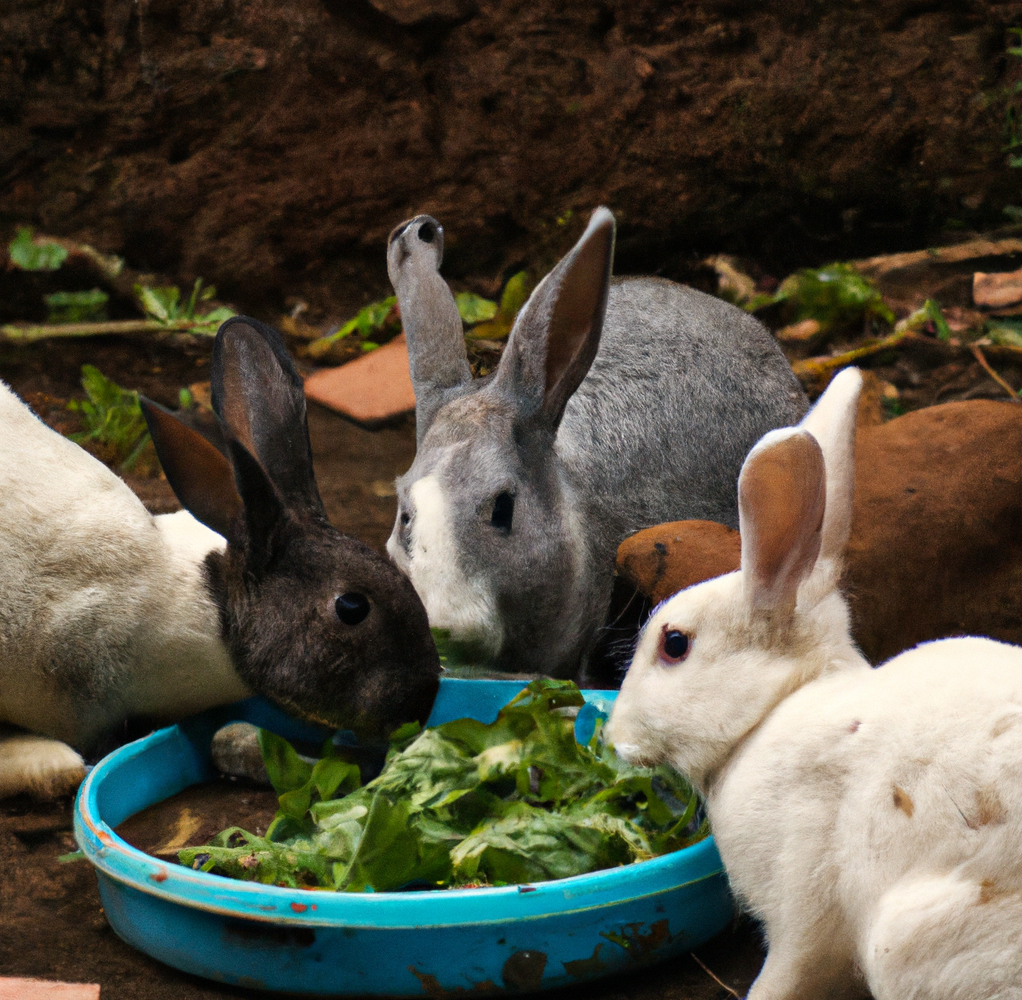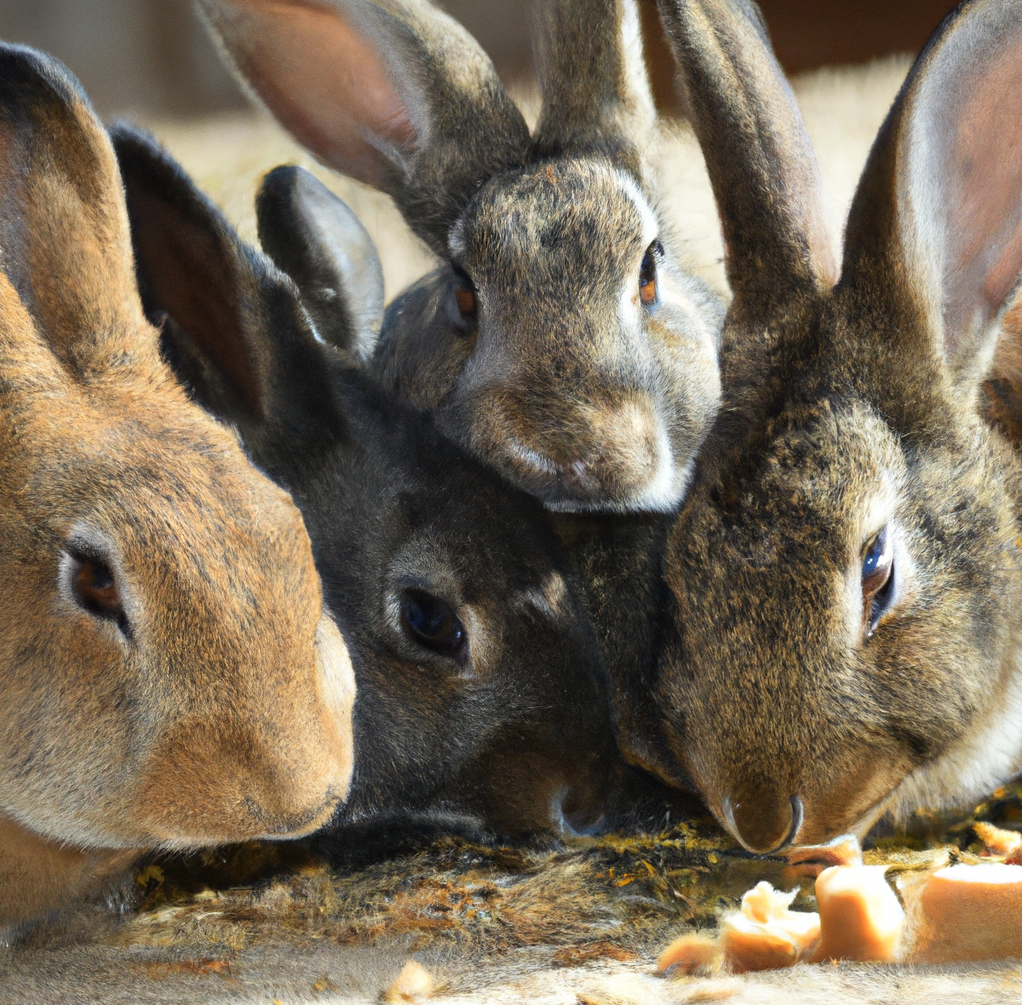Rabbits can be both wild and domestic animals. Wild rabbits are a different species than domestic rabbits and they have different behaviors and needs. It is possible for wild and domestic rabbits to live together, but this is dependent on several factors. This article will explore the differences between wild and domestic rabbits, the potential risks of living together, and the best ways to ensure that wild and domestic rabbits can live harmoniously together.
The Pros and Cons of Keeping Wild and Domestic Rabbits Together
The decision to keep wild and domestic rabbits together is one that should be weighed carefully. While there are potential benefits to such a setup, there are also potential drawbacks that must be taken into consideration.
Pros
The primary benefit of keeping wild and domestic rabbits together is that it may help to reduce stress. Wild rabbits, who are not accustomed to human contact, can be easily stressed by the presence of humans. Keeping them with domestic rabbits, who are used to human contact, can help to make them more comfortable in their environment. This can help to prevent health issues that can be caused by stress.
Another potential benefit is that it may help to reduce the likelihood of aggression between the two species. As wild rabbits may not be familiar with domestic rabbits, they may not know how to interact with them, leading to aggressive behaviour. Keeping the two species together may help them to learn how to interact safely and peacefully.
Cons
One of the primary drawbacks of keeping wild and domestic rabbits together is that it can be difficult to ensure that they are both receiving adequate nutrition. Wild rabbits may be accustomed to a diet of wild plants and grasses, while domestic rabbits may need a different diet that includes hay and fresh vegetables. If their diets are not properly balanced, it could lead to health issues for both species.
In addition, wild rabbits may carry diseases or parasites that domestic rabbits are not accustomed to. If the two species are kept together, the domestic rabbits may be exposed to these diseases or parasites, which could lead to serious health issues.
Overall, the decision to keep wild and domestic rabbits together should not be taken lightly. While there may be potential benefits, there are also potential drawbacks that must be taken into consideration. Careful research and planning should be done to ensure that both species are receiving the proper nutrition and care they need to stay healthy and happy.
Understanding the Risks of Allowing Wild and Domestic Rabbits to Coexist

Allowing wild and domestic rabbits to coexist can have serious risks for both species. Domestic rabbits can be vulnerable to disease and injury from wild rabbits, while wild rabbits may suffer from the same dangers as well as being exposed to potential non-native diseases from the domestic species. Additionally, the presence of domestic rabbits in the wild can disrupt the natural dynamics of wild rabbit populations, leading to overpopulation and competition for resources.
For domestic rabbits, the risks of coexistence can be serious. Wild rabbits may have diseases not present in domestic rabbits, such as tularemia, which can be fatal. Additionally, parasites and other infections can be transferred between the two species, leading to illness and even death. Domestic rabbits may also suffer physical trauma from encounters with wild rabbits, such as bites or scratches, and wild rabbits may be aggressive if they feel threatened.
Wild rabbits may also suffer from the presence of domestic rabbits. Non-native diseases can be introduced to wild rabbit populations, leading to illness and death in the wild species. Additionally, competition for resources can lead to overcrowding and an overabundance of rabbits, which can lead to food shortages and other problems. In some cases, wild rabbit populations can become so overpopulated that they become unsustainable and may have to be culled.
In order to reduce the risks of allowing wild and domestic rabbits to coexist, domestic rabbits should be kept in enclosures or areas that are away from wild rabbit populations. Additionally, domestic rabbits should be regularly checked for parasites and other illnesses, and immunizations should be kept up to date. If possible, wild rabbit populations should also be monitored to ensure that there are no signs of illness or overcrowding, and that resources are being managed responsibly.
Overall, allowing wild and domestic rabbits to coexist can pose serious risks to both species. By understanding the potential risks and taking steps to ensure the safety of both species, it is possible to reduce the potential harms associated with coexistence.
Exploring the Health Benefits of Keeping Wild and Domestic Rabbits Together
Keeping both wild and domestic rabbits together has a number of potential health benefits for both animals. From preventing the spread of diseases to providing companionship and stress relief, the advantages of this practice are far-reaching.
One of the most important benefits of keeping wild and domestic rabbits together is disease prevention. By housing wild and domestic rabbits together, the chances of disease transmission are greatly reduced. Wild rabbits are more likely to carry illnesses that can be passed on to domestic rabbits if they are kept separately, but by housing them together, the chances of this happening are significantly reduced.
Domestic rabbits can also benefit from having a wild companion. Wild rabbits are more active than their domestic counterparts, meaning that domestic rabbits can benefit from the exercise and stimulation provided by their wild playmates. This can help to keep domestic rabbits mentally and physically healthy and can help to reduce stress levels.
Moreover, having a wild companion can be beneficial for the mental health of domestic rabbits. Rabbits are social animals and having a wild playmate can provide companionship and stimulation. This can help to reduce loneliness and boredom, which can have a positive effect on their overall wellbeing.
Finally, wild rabbits can provide a natural source of food for their domestic counterparts. Wild rabbits can provide their domestic relatives with a variety of nutritious foods, such as grasses, herbs, and other plant matter. This can help to ensure that domestic rabbits receive a balanced diet and stay healthy.
In conclusion, there are a number of potential health benefits to keeping wild and domestic rabbits together. From preventing the spread of diseases to providing companionship and stress relief, the advantages of this practice are far-reaching. It is important to note, however, that these benefits can only be achieved if rabbits are properly cared for and housed in a safe and secure environment.
Creating a Safe Environment for Wild and Domestic Rabbits to Live Harmoniously

Creating a safe environment for wild and domestic rabbits to live harmoniously is a complex task that requires thoughtful consideration of the needs of both species. Domestic rabbits, which are descendants of European wild rabbits, have been bred to be much smaller and to have shorter ears, legs, coats, and tails than their wild counterparts. As a result, they tend to be more vulnerable to predators and environmental stressors.
When creating a safe environment for both wild and domestic rabbits, it is important to create a habitat that meets the needs of both species. This includes providing adequate food, water, and shelter for both species, as well as ensuring that the habitat is free from potential predators and other environmental hazards.
In terms of food and water, it is important to provide a variety of sources for both wild and domestic rabbits. Wild rabbits typically thrive on a diet of grasses, grains, and legumes, while domestic rabbits primarily need a diet of hay and commercial rabbit food. It is also important to provide a consistent source of clean water for both species.
When it comes to shelter, wild rabbits will usually construct their own burrows, while domestic rabbits need a secure enclosure that is protected from predators. It is also important to provide places where both species can hide or take refuge in case of danger.
Finally, it is essential to create a habitat that is free from potential predators. This includes keeping cats and dogs contained or supervised when they are outdoors, as well as ensuring that any other potential predators, such as foxes, hawks, and snakes, are not living in or near the habitat.
By taking the necessary steps to create a safe environment for both wild and domestic rabbits, it is possible to create a harmonious environment for both species to thrive and coexist peacefully.
How to Prevent Territorial Disputes Between Wild and Domestic Rabbits
Domestic rabbits and wild rabbits often come into contact with one another, leading to territorial disputes. These disputes can become dangerous, so it is important to take steps to prevent them.
One way to prevent territorial disputes between wild and domestic rabbits is to ensure that there is adequate space for all rabbits in the area. If there is too little space, wild rabbits may feel the need to protect their territory, leading to disputes. If possible, provide plenty of natural vegetation and other resources for the wild rabbits.
It is also important to keep domestic rabbits away from wild rabbit areas. Domestic rabbits should not be allowed to roam freely in areas where wild rabbits are known to live. If a wild rabbit encounters a domestic rabbit in its territory, it may become aggressive.
It is also important to provide domestic rabbits with adequate shelter. If a domestic rabbit does not have access to a safe, enclosed space, it may attempt to establish its own territory, leading to disputes with wild rabbits. Providing a secure enclosure for domestic rabbits can help to reduce the risk of territorial disputes.
Finally, it is important to be aware of the signs of territorial disputes between wild and domestic rabbits. If a rabbit appears to be aggressive or territorial, it is important to separate the rabbits immediately to prevent a fight.
By taking these steps, it is possible to prevent territorial disputes between wild and domestic rabbits. Doing so can help to keep all rabbits in the area safe and healthy.
What to Look for When Introducing a Wild Rabbit to a Domestic Rabbit
When introducing a wild rabbit to a domestic rabbit, it is important to take appropriate precautions to ensure the safety of both animals. Below are some key factors to consider before introducing the two rabbits:
1. Health: Both rabbits should be examined by a veterinarian to ensure they are healthy and do not have any contagious diseases. Additionally, it is important to ensure that both rabbits have been spayed or neutered.
2. Environment: It is important to introduce the rabbits in a neutral environment, such as a large, neutral-scented room. The room should be free of distractions and have plenty of hiding places, such as boxes and tunnels, for the rabbits to explore.
3. Supervision: Introducing the rabbits should be done slowly and under direct supervision. The rabbits should be kept separated until they are comfortable with each other.
4. Diet: The rabbits should be fed separately and given the same type of food. This will help to ensure that the wild rabbit is getting the same nutrition as the domestic rabbit.
5. Time: It is important to give the rabbits time to adjust to each other’s presence. Introducing the rabbits slowly and allowing them time to explore and get accustomed to each other is essential for a successful introduction.
By following these steps and keeping a close eye on the rabbits, it is possible to successfully introduce a wild rabbit to a domestic rabbit. With patience, understanding, and proper care, these two rabbits can learn to coexist peacefully.
Finding the Right Balance of Diet and Exercise for Wild and Domestic Rabbits
Rabbits, both wild and domestic, require a balanced diet and regular exercise for optimal health. Proper nutrition and exercise are essential for maintaining the body condition of rabbits, helping to prevent obesity, and promoting overall well-being. In this article, we will explore the dietary requirements and exercise needs of wild and domestic rabbits.
Dietary Requirements
Wild rabbits have a diet that is mainly made up of fresh grasses, herbs and clover. They also consume small amounts of vegetables, fruits and nuts. Domestic rabbits have a more varied diet that is made up of hay, fresh vegetables, and a small amount of commercial rabbit food. It is important to ensure that both wild and domestic rabbits have access to fresh, clean water at all times.
Exercise
Wild rabbits have access to a natural environment and are able to roam and explore freely. This allows them to get adequate exercise that helps to maintain their body condition. Domestic rabbits, on the other hand, require more controlled exercise. Providing them with a safe and enclosed space to play and explore, such as a rabbit run, is essential for their physical and mental health. Additionally, allowing them to interact with people and other animals can help increase their physical activity.
In summary, wild and domestic rabbits require a balanced diet and regular exercise for optimal health. Wild rabbits are able to get enough exercise in their natural environment, while domestic rabbits need more controlled exercise, such as a rabbit run or interaction with people and other animals. It is important to ensure that both types of rabbits always have access to fresh, clean water. With the right balance of diet and exercise, wild and domestic rabbits can enjoy a healthy and happy life.
Examining the Social Differences Between Wild and Domestic Rabbits and How to Bridge Them
Rabbits, both wild and domestic, are an incredibly sociable species, but they have many differences between them. Wild rabbits live in large groups and are highly organised, while domestic rabbits are often kept as individuals and are not as organised. This can lead to social differences between the two, which can be difficult to bridge. However, through understanding their natural behaviour, we can learn how to bridge the social differences between wild and domestic rabbits.
In the wild, rabbits live in large groups known as colonies. Colonies are made up of related rabbits, with a male and female at the top. This hierarchy helps to keep the group organised, and is important for the survival of the colony. The main rabbits in the group are responsible for defending the colony, and for finding food and water for the group.
Domestic rabbits, on the other hand, are often kept as individuals. This can lead to social problems, as they do not have the same hierarchy and organisation as wild rabbits. As a result, they can become bored, anxious, and aggressive.
In order to bridge the social differences between wild and domestic rabbits, it is important to understand their natural behaviour. For example, domestic rabbits should be kept in groups, as this more closely mimics their natural behaviour. It is also important to provide plenty of enrichment activities, such as toys and tunnels, to keep them stimulated.
It is also important to ensure that your rabbit is spayed or neutered. This will prevent fighting and aggression between rabbits, as well as reducing the risk of disease.
Finally, it is important to provide your rabbit with a safe and secure environment. This means ensuring that your rabbit has plenty of space to move around and explore, and that it is protected from predators and other dangers.
Wild and domestic rabbits have many differences between them, but through understanding their behaviour and providing them with the right environment, we can help to bridge the social differences between them. By understanding how to provide the best environment for your rabbit, you can ensure that it is happy and healthy.
Conclusion
In conclusion, it is generally not recommended for wild and domestic rabbits to live together due to the risks involved. Domestic rabbits can be exposed to diseases and parasites that wild rabbits may carry, and wild rabbits may become aggressive and territorial towards their domestic counterparts. If you are considering housing wild and domestic rabbits together, it is important to consult a veterinarian or animal behaviorist to ensure that the environment is safe and appropriate for both.

